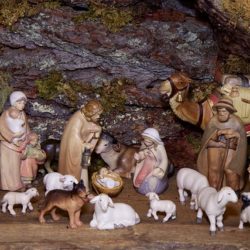Lessons from the Last Supper

The Last Supper stands as one of history’s most significant meals, transcending its religious origins to become a powerful cultural symbol and source of timeless wisdom. This historic gathering, which took place on the first day of Passover, has been immortalized in art, literature, and religious practice worldwide. Beyond its theological importance, this final meal shared between Jesus and his disciples offers profound insights into human relationships, leadership, and personal ethics that resonate across cultural and religious boundaries.
The Historical Context
The Last Supper occurred within the framework of the Jewish Passover celebration, a festival commemorating Israel’s liberation from slavery in Egypt. According to biblical accounts, Jesus sent his disciples ahead into the city to prepare this special meal in Jerusalem, which would become his final gathering with them before his crucifixion
Tradition places this momentous meal in a room now called “The Room of the Last Supper,” located on Mount Zion, just outside Jerusalem’s walls. This setting provided the backdrop for several transformative teachings and actions that would influence billions of people throughout history.
Lesson of Humble Service: Washing the Disciples’ Feet
Perhaps the most striking demonstration during the Last Supper was Jesus’s act of washing his disciples’ feet—a task normally reserved for the lowest servants.
- Breaking Social Hierarchy: By performing this menial task, Jesus deliberately inverted the expected social order.
- Leading by Example: Rather than merely instructing his followers about service, Jesus physically demonstrated it.
- Practical Humility: This wasn’t philosophical humility but practical service addressing a real need—cleaning feet dusty from Jerusalem’s unpaved roads.
The significance of this act becomes clearer when we consider the reaction it provoked. Peter initially refused to let Jesus wash his feet, seemingly uncomfortable with this reversal of status. This response highlights how challenging true humility can be, especially when it disrupts our expectations about authority and position.
Lesson of Radical Inclusion: Washing Judas’s Feet
A frequently overlooked detail of the foot-washing narrative carries particular power:
The Savior washed Judas’ feet along with the others. Jesus was aware that within a few hours he would brutally, violently die. He knew Judas Iscariot would betray him. And yet he washed his feet, too.
- Extending Service to Enemies: The act demonstrates serving even those who may harm us.
- Transcending Tribalism: It challenges our tendency to divide people into worthy and unworthy of our care.
- Consistency of Character: It reveals integrity in action regardless of how one is treated in return.
This aspect of the Last Supper presents perhaps its most challenging lesson—maintaining dignity and principle even toward those who oppose us.
Lesson of Self-Reflection: “Lord, Is It I?”
When Jesus announced that one disciple would betray him, an interesting response followed. Rather than pointing fingers at others, the disciples first looked inward, asking, “Lord, is it I?”.
- Self-examination before judgment: Looking inward before accusing others
- Openness to correction: Willingness to consider personal failings
- Humility in receiving guidance: Recognizing one’s own potential for error
This response stands in stark contrast to how humans often react to criticism or difficult messages—by immediately assuming they apply to others rather than ourselves. The Last Supper teaches a more reflective approach.
Lesson of Remembrance: The Institution of Communion
During the meal, Jesus established what would become one of Christianity’s most enduring practices:
He took a loaf of bread and broke off pieces to give to each disciple. He said His body would be broken for them just like the bread. Then He poured wine for them and said His blood would be poured out for them just like the wine.
- The Power of Ritual: How shared symbolic practices can unite diverse communities
- Embodied Memory: Using physical elements (food and drink) to remember important truths
- Sacrifice and Service: Reinforcing commitment to others through symbolic sharing
Today, this practice continues to unite Christians across denominational lines, with Rob Douglas, a Baptist minister, noting that “despite all of our differences, that meal is the one uniting factor”.
Lesson of Identity and Purpose: “The Way, The Truth, and The Life”
At this final gathering, Jesus articulated key aspects of his identity and mission with the statements “I am the Way, the Truth, and the Life” and “I am the True Vine”.
- Authentic Leadership: Clearly articulating one’s values and vision
- Relational Connection: Emphasizing interdependence (“vine and branches”)
- Purpose Clarity: Providing clear direction in uncertain times
Even in a secular context, these principles of clear identity, authentic connection, and purposeful direction remain valuable leadership lessons.
Lesson of Preparing for Challenges: The Garden Prayer
After the meal, Jesus and his disciples went to a garden where Jesus prayed about the difficulties ahead.
- Emotional Honesty: Acknowledging fear and struggle rather than projecting false confidence
- Seeking Support: Asking companions to “keep watch” during difficult moments
- Aligning with Purpose: Reconciling personal desire with broader commitment
This vulnerable preparation for difficulty provides a template for approaching our own challenges with authenticity and courage.
Universal Applications for Today
While rooted in a specific religious context, the lessons from the Last Supper transcend cultural and faith boundaries:
- Leadership Models: Servant leadership that prioritizes others’ needs above status or convenience
- Ethical Frameworks: Inclusion that extends beyond comfortable boundaries
- Personal Development: Self-reflection that starts with examining our own actions
- Community Building: Symbolic practices that create shared identity and purpose
- Conflict Management: Maintaining principle and dignity even with adversaries
These applications make the Last Supper story relevant regardless of one’s religious perspective, offering wisdom for personal relationships, professional environments, and community engagement.
Conclusion
The Last Supper represents more than a religious commemoration—it provides a rich tapestry of lessons about how we might better engage with others and ourselves. From radical service to courageous self-reflection, from inclusive community to purposeful identity, this ancient meal continues to offer fresh insights for contemporary challenges.
In a world often characterized by divisiveness, status-seeking, and blame-shifting, these principles offer a compelling alternative vision—one where leadership means service, community includes the difficult, and growth begins with honest self-examination.


























